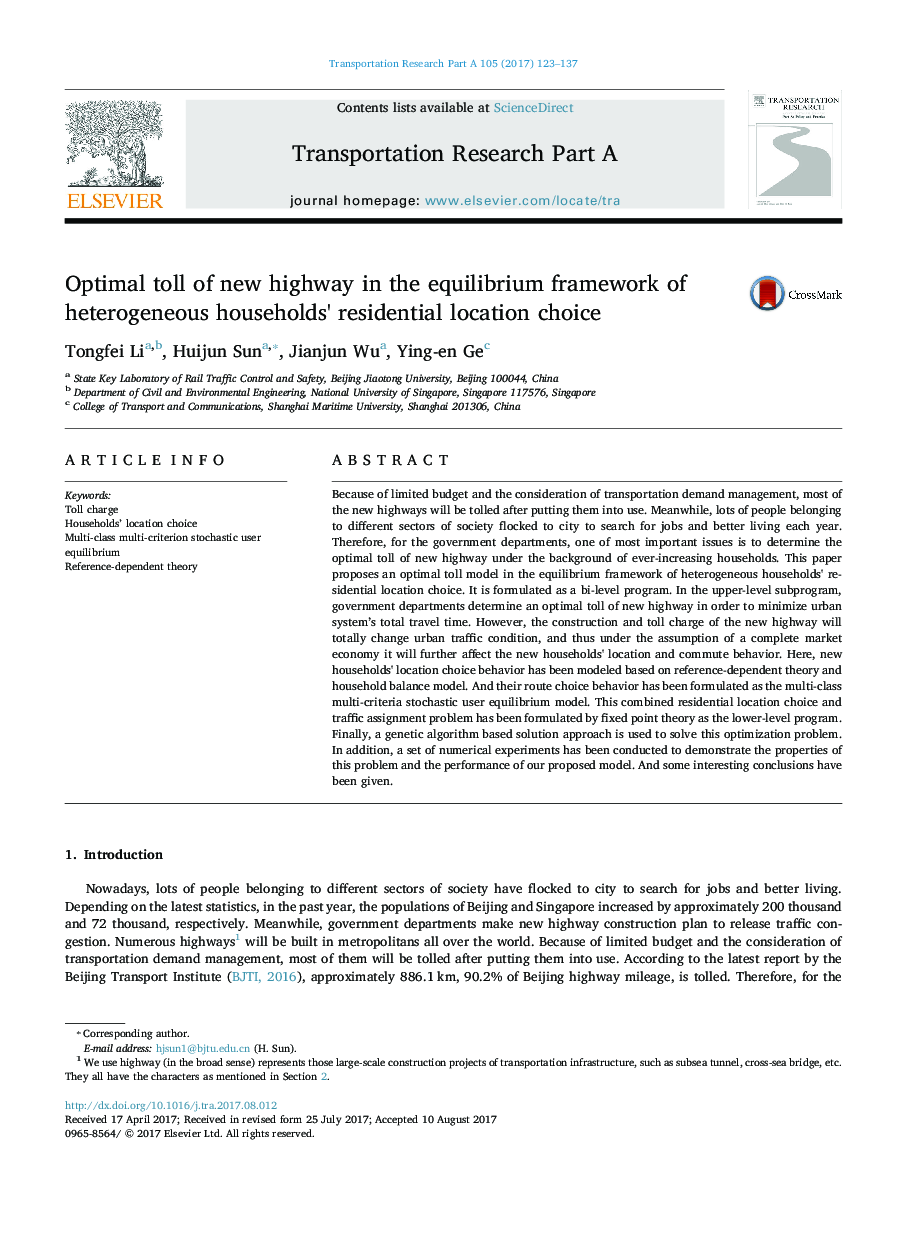| کد مقاله | کد نشریه | سال انتشار | مقاله انگلیسی | نسخه تمام متن |
|---|---|---|---|---|
| 4928853 | 1432195 | 2017 | 15 صفحه PDF | دانلود رایگان |
عنوان انگلیسی مقاله ISI
Optimal toll of new highway in the equilibrium framework of heterogeneous households' residential location choice
ترجمه فارسی عنوان
عوارض بهینه از بزرگراه جدید در چارچوب تعادل از انتخاب محل سکونت خانوارهای ناهمگن
دانلود مقاله + سفارش ترجمه
دانلود مقاله ISI انگلیسی
رایگان برای ایرانیان
کلمات کلیدی
شارژ تلفن خانوار انتخاب محل تعادل کاربری چند متغیره چند طبقه ای، تئوری وابسته به مرجع،
ترجمه چکیده
به دلیل بودجه محدود و توجه به مدیریت تقاضای حمل و نقل، بسیاری از بزرگراه های جدید پس از قرار دادن آنها در استفاده از مزایده می شود. در همین حال، تعداد زیادی از افراد متعلق به بخش های مختلف جامعه به شهر برای جستجوی شغل و زندگی بهتر در هر سال سرازیر شدند. بنابراین، برای ادارات دولتی، یکی از مهمترین مسائل، تعیین میزان تلفات بهینه از بزرگراه های جدید در زمینه خانواده های در حال افزایش است. این مقاله یک مدل تلفیقی بهینه در چارچوب تعادل انتخاب محل سکونت خانوارهای ناهمگن پیشنهاد می کند. این یک برنامه دو سطحی است. در بخش زیرسطحی سطح بالا، ادارات دولتی به منظور به حداقل رساندن کل زمان سفر به سیستم شهری، تلفات بهینه از بزرگراه جدید را تعیین می کنند. با این حال، ساخت و پرداخت هزینه های بزرگراه جدید به طور کامل شرایط ترافیک شهری را تغییر خواهد داد، و در نتیجه با فرض یک اقتصاد بازار کامل، این امر بیشتر بر موقعیت های جدید خانوارها و رفت و آمد رفت و آمد تاثیر خواهد گذاشت. در اینجا، رفتار انتخابی خانوارهای جدید براساس نظریه وابسته به مرجع و مدل تعادل خانوار مدل سازی شده است. و رفتار انتخاب مسیر خود را به عنوان مدل تعادلی کاربر چند متغیر است تصادفی مدل تعریف شده است. این انتخاب ترکیبی مسکونی انتخاب و تخصیص ترافیک مشکل توسط نظریه نقطه ثابت به عنوان برنامه سطح پایین فرموله شده است. در نهایت، یک راه حل مبتنی بر الگوریتم ژنتیکی برای حل این مشکل بهینه سازی استفاده می شود. علاوه بر این، مجموعه ای از آزمایش های عددی برای نشان دادن خواص این مشکل و عملکرد مدل پیشنهادی ما انجام شده است. و برخی از نتایج جالبی داده شده است.
موضوعات مرتبط
مهندسی و علوم پایه
سایر رشته های مهندسی
مهندسی عمران و سازه
چکیده انگلیسی
Because of limited budget and the consideration of transportation demand management, most of the new highways will be tolled after putting them into use. Meanwhile, lots of people belonging to different sectors of society flocked to city to search for jobs and better living each year. Therefore, for the government departments, one of most important issues is to determine the optimal toll of new highway under the background of ever-increasing households. This paper proposes an optimal toll model in the equilibrium framework of heterogeneous households' residential location choice. It is formulated as a bi-level program. In the upper-level subprogram, government departments determine an optimal toll of new highway in order to minimize urban system's total travel time. However, the construction and toll charge of the new highway will totally change urban traffic condition, and thus under the assumption of a complete market economy it will further affect the new households' location and commute behavior. Here, new households' location choice behavior has been modeled based on reference-dependent theory and household balance model. And their route choice behavior has been formulated as the multi-class multi-criteria stochastic user equilibrium model. This combined residential location choice and traffic assignment problem has been formulated by fixed point theory as the lower-level program. Finally, a genetic algorithm based solution approach is used to solve this optimization problem. In addition, a set of numerical experiments has been conducted to demonstrate the properties of this problem and the performance of our proposed model. And some interesting conclusions have been given.
ناشر
Database: Elsevier - ScienceDirect (ساینس دایرکت)
Journal: Transportation Research Part A: Policy and Practice - Volume 105, November 2017, Pages 123-137
Journal: Transportation Research Part A: Policy and Practice - Volume 105, November 2017, Pages 123-137
نویسندگان
Tongfei Li, Huijun Sun, Jianjun Wu, Ying-en Ge,
